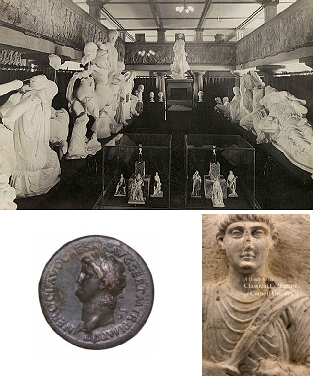Newly reissued guide chronicles Cornell's extensive classical art collection
Newly reissued guide chronicles Cornell's extensive classical art collection
In ancient times—well, up until the Nineties, but ancient history to current undergrads—the name of the old Temple of Zeus café in Goldwin Smith Hall was as much descriptive as it was triumphal. Before a renovation moved the eatery to its current spot, the café featured ledges along the walls bearing elegant, imposing casts of pedi-mental sculptures from the Temple of Zeus at Olympia. Nowadays, scholars in search of a caffeine boost have to settle for a more modest layout—albeit one decorated with casts of Parthenon friezes. Too big to fit in the renovated café, the Zeus casts have been relocated to the Arts and Sciences admissions office, where they gaze down on couch-loads of nervous high schoolers.
Classical art has had a home at Cornell since its founding; first president A. D. White ordered hundreds of plaster casts of Greek and Roman statuary (paid for by benefactor Henry Sage) to expose students to ancient cultural artifacts that few could afford to view abroad. In 1894, when the 5,000-square-foot Museum of Casts formally opened in the basement of McGraw Hall, the New York Times praised it as "excelled by no other university museum in the United States, and among other foundations only by the Museum of Fine Arts of Boston."
In the intervening century, though, the casts were dispersed across campus—or, worse, destroyed. In the early Sixties, as archaeology professor emeritus Peter Kuniholm laments, "aesthetic tastes were that either you had the original or you don't have anything at all. Harvard threw its entire collection out; they got some hammers and 'put an end to all the lies.' At Penn they found an empty elevator shaft and threw them all down." Luckily, though, Cornell's purge was less comprehensive. "We trashed about half the collection," Kuniholm says, "and I've spent the last thirty-five years trying to rehabilitate these things, which is not easy because there's no place to put them."

The casts—and Cornell's other classical holdings, from pottery to coins to memorial steles—are celebrated in a newly re-issued book by Kuniholm and two colleagues. Published jointly by the Johnson Museum and Cornell University Press, A Guide to the Classical Collections of Cornell University focuses on about five dozen objects representing a collection of some 12,000 (a quarter of which are coins). Written with art historians Andrew and Nancy Ramage and edited by Jane Terrell '02, the book was privately published by the museum in 2003 but without an ISBN number that would allow for wide distribution. Still, the initial 1,000 copies sold out over the years, so it was time for a reprint. Unfortunately, the original Milanese publisher had changed hands several times, and the electronic files had been lost. Kuniholm spent last summer recreating them, and the new guide—printed in Istanbul—was released in January. Priced at $19.95, it's available at the Cornell Store, the Johnson Museum, and from online sources like amazon.com.
In addition to detailed descriptions of such gems as a head of Augustus Caesar dating from the first century A.D. and an Etruscan cinerary urn from the third or fourth century B.C., the guide offers a "stroller's companion" to where various objects are housed on campus; the Johnson Museum itself has space to display only about two dozen.
Absent, though, is an observation that Kuniholm made during the production process regarding the uncanny resemblance between Emperor Nero's profile on a Sestertius and a certain Big Red hockey coach (and 1986 Cornell grad). "I did not say what I thought about one of the Roman coins," Kuniholm says, "which is that it looks just like Mike Schafer."



